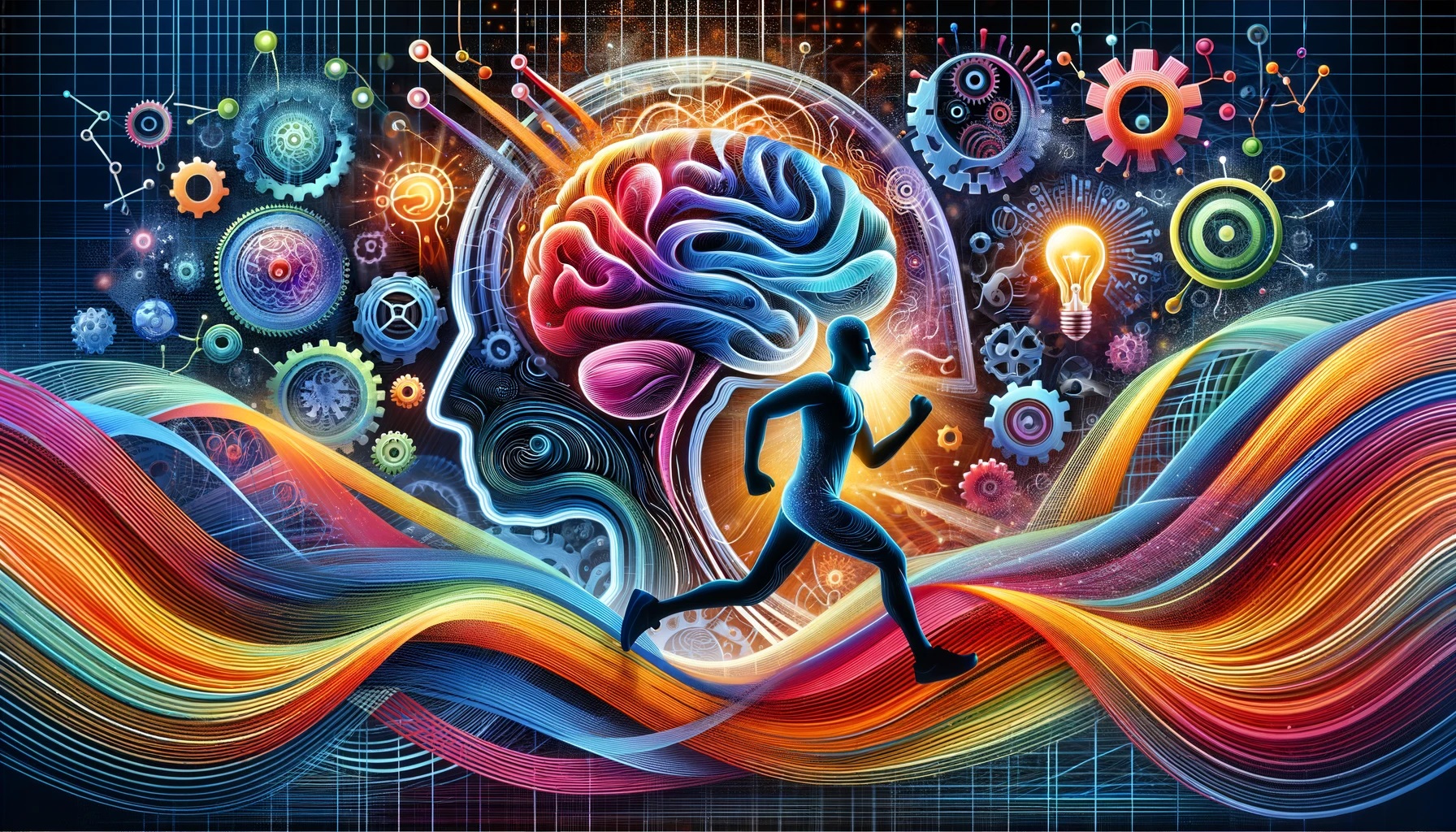· nutrition · 16 min read
Optimizing Iron Absorption in a Tannin-Rich Diet
Discover how tannins impact iron absorption and learn strategies for optimizing iron intake in your diet, despite the presence of these astringent compounds.
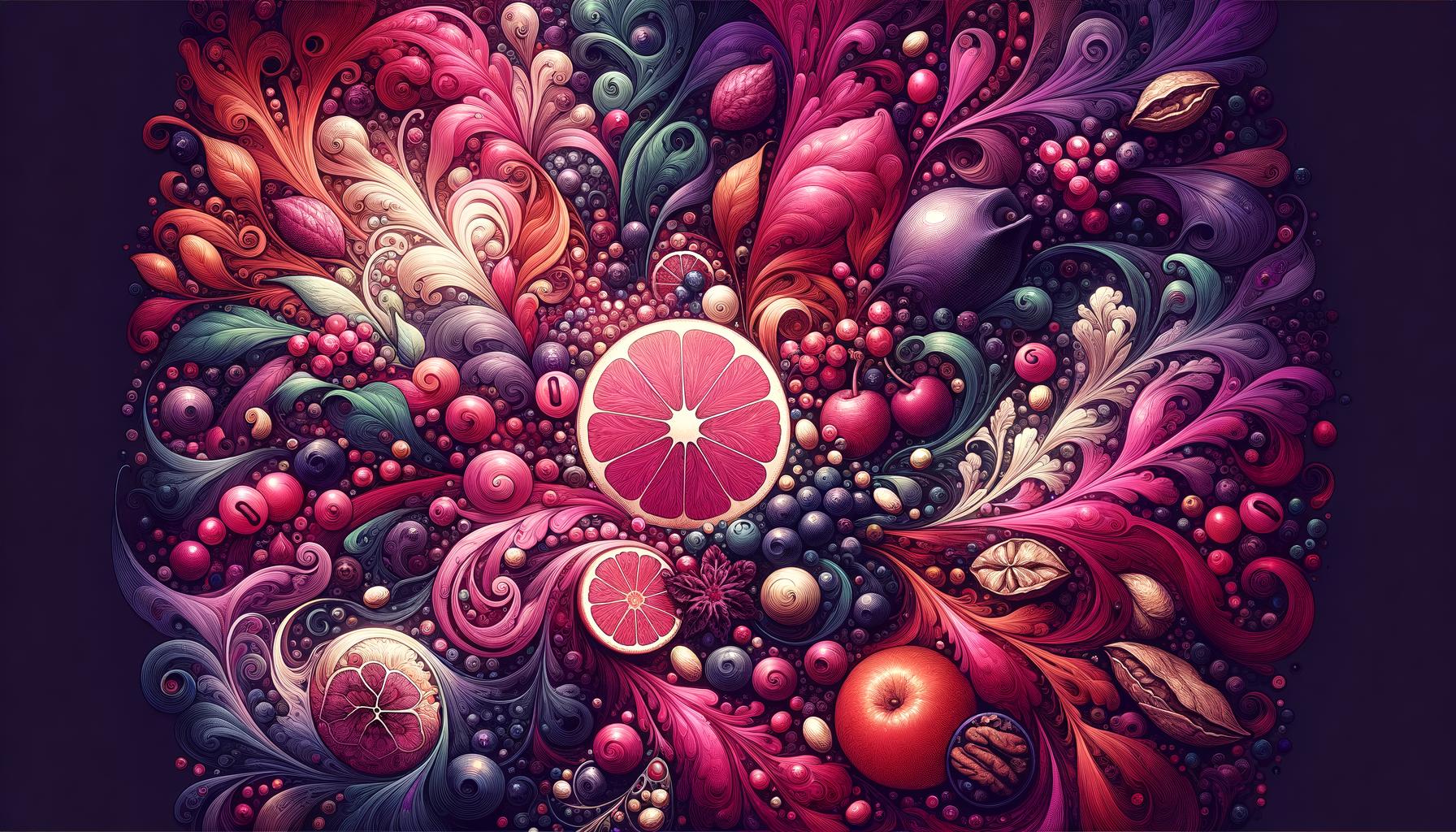
In This Post
The Fact Why Should I Care How To Put In Action Start Tomorrow Guide How does it effect my ability to focus How does it impact my daily life How does it help me make friends How does it help me manage stress How does it effect my mood Summary: Remember Refresher Checklist The Full Research Article CitationsPrint Out The Tomorrow Checklist!
Sign up for our newsletter and receive a copy today, so that, you can start tomorrow! Or the next day, or the day after that. I forget everything and starting things is hard at least for me so these checklists are godsend.
Print Out The Remember Refresher Checklist!
Sign up for our newsletter and download your own copy of the Remember Refresher Checklist, so that, you can easily put it on your fridge and help you stay on target towards your WHY. Every little bit helps.
Introduction to Tannins and Iron Absorption

Tannins and iron play significant roles in our nutrition, albeit in complex and sometimes conflicting ways. Understanding their interaction can be crucial for anyone looking to optimize their dietary iron absorption, particularly those on plant-based diets or with conditions leading to iron deficiency. This section will delve into the essential functions of tannins in nutrition and the mechanisms underlying iron absorption.
The Vital Role of Tannins in Nutrition
Tannins, a group of astringent compounds widely present in plant-based foods and beverages, are recognized for their antioxidant properties. These polyphenols are found in a variety of dietary sources, including tea, coffee, red wine, and many fruits and vegetables. While often lauded for their health benefits, including reducing inflammation and fighting free radicals, tannins also have a less favorable aspect: they can inhibit the absorption of dietary iron.
Understanding Iron Absorption and its Dietary Importance
Iron is a crucial mineral that plays a vital role in forming hemoglobin, a protein in red blood cells that carries oxygen throughout the body. There are two types of iron found in foods: heme iron, which is readily absorbed by the body and found in animal products, and non-heme iron, which is more common in plant-based sources and has lower bioavailability.
The process of iron absorption is complex and can be influenced by various dietary factors, including the presence of tannins. Tannins bind to non-heme iron, creating a complex that the intestine has difficulty absorbing. This interaction can lead to reduced iron bioavailability from plant sources, posing a challenge for vegetarians, vegans, and those at risk of iron deficiency.
To navigate through these nutritional nuances, it’s essential to adopt strategies that can help minimize tannins’ impact on iron absorption while still benefiting from their antioxidant properties. These include timing the consumption of tannin-rich foods and combining non-heme iron sources with vitamin C to enhance iron bioavailability.
- Consume tannin-rich foods and beverages separately from iron-rich meals.
- Include vitamin C-rich foods in meals to enhance non-heme iron absorption.
- Opt for heme iron sources, if possible, for higher bioavailability.
- Consider iron supplementation under medical guidance if dietary adjustments are
insufficient.
By understanding and adjusting our dietary habits around the presence of tannins, we can optimize iron absorption, ensuring that our nutritional needs are met while still enjoying the health benefits of these potent antioxidants.
The Impact of Tannins on Health
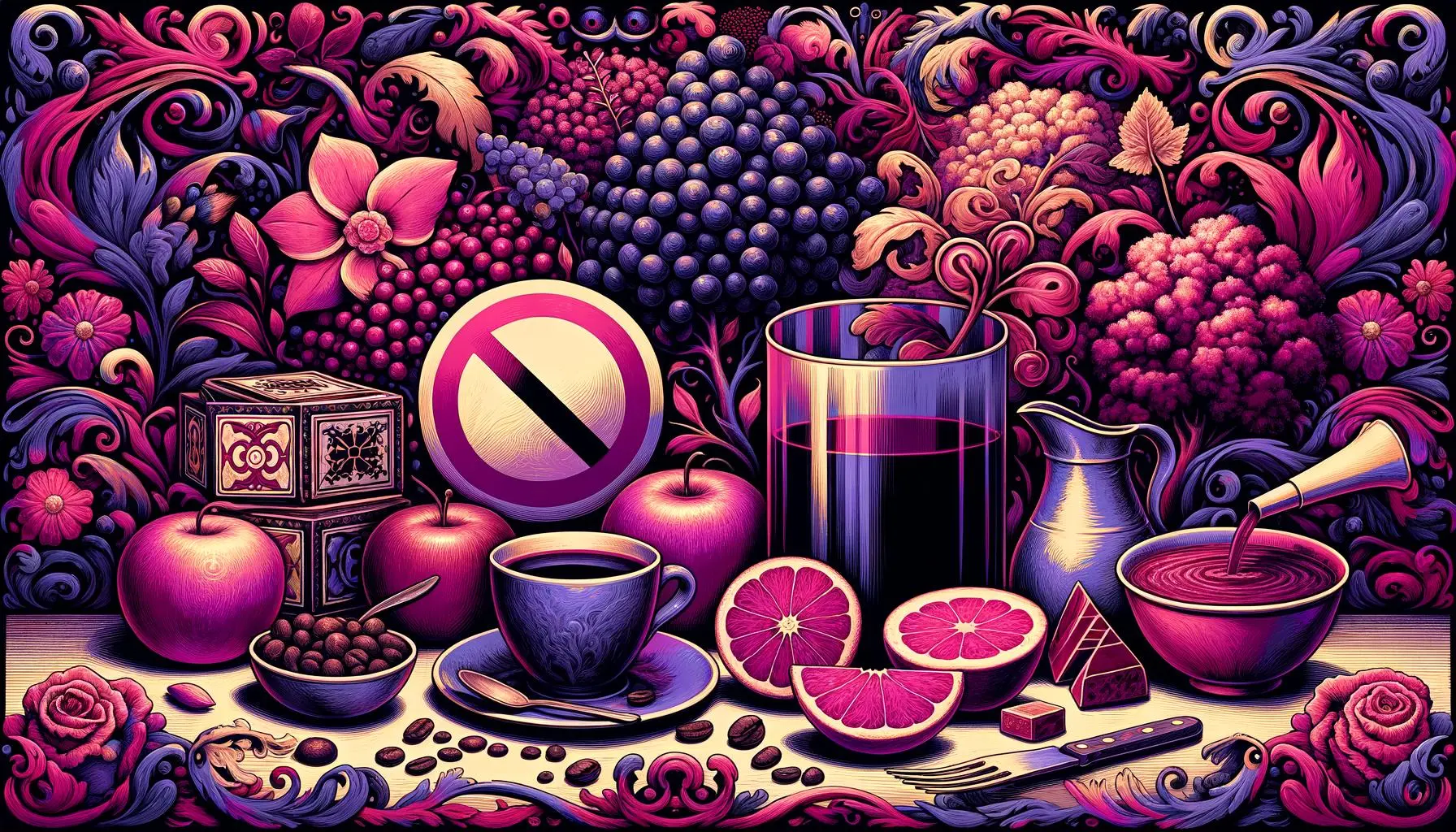
Tannins, a group of polyphenolic compounds found in many plant-based foods and beverages, have long been recognized for their antioxidant properties. These natural substances, present in a variety of fruits, teas, wines, and even chocolate, act as powerful antioxidants that can protect the body from harmful free radicals. However, while the health benefits of antioxidants are well-documented, tannins carry a unique paradox in their relationship with dietary iron, particularly from plant sources. This dual role garners them the label of a “double-edged sword” within nutritional science.
Tannins: Antioxidants with a Double-Edged Sword
Tannins are acclaimed for their ability to act as antioxidants. These compounds can neutralize free radicals, reduce inflammation, and even lower the risk of certain diseases. However, it’s their interaction with non-heme iron, the form of iron predominant in plant-based foods, that brings to light their complex role in nutrition. Despite their health benefits, tannins can significantly inhibit iron absorption, a concern especially pertinent for those on plant-based diets or individuals at risk of iron deficiency.
The astringent nature of tannins, responsible for the characteristic dry and puckering sensation experienced when consuming foods like unripe fruits or strong tea, reflects their ability to bind and precipitate proteins. In the digestive tract, this same property enables them to bind with non-heme iron, preventing its absorption. Given the importance of iron in transporting oxygen throughout the body and supporting immune function, understanding and managing tannin consumption is crucial for maintaining optimal iron levels.
How Tannins Interfere with Iron Absorption from Plant Sources
The mechanism by which tannins inhibit iron absorption is both fascinating and relevant for dietary planning. When tannins bind with iron in the intestines, they form an insoluble complex that the body cannot absorb. This interaction is particularly significant for those relying on plant-based sources of iron, such as leafy greens, legumes, and whole grains, where non-heme iron predominates.
Here’s a checklist for identifying common tannin-rich foods that may impact iron absorption:
- Black tea
- Green tea
- Coffee
- Red wines
- Berries (raspberries, blackberries, strawberries)
- Nuts (especially almonds, walnuts, and hazelnuts)
- Dark chocolate
- Some beans (like kidney beans and black beans)
- Whole grains high in tannins (e.g., sorghum, millet, barley)
Awareness of the tannin content in these foods and beverages can facilitate better dietary decisions, particularly for those focused on enhancing their iron intake. While it’s not necessary to eliminate these antioxidant-rich foods from the diet, understanding their potential to inhibit iron absorption underscores the importance of strategic consumption, especially in meals designed to maximize dietary iron intake.
This segment sheds light on the complex relationship between tannins and iron absorption, highlighting the necessity for balanced nutritional strategies that account for both the health benefits and potential drawbacks of tannins in the diet.
Dietary Strategies for Optimizing Iron Absorption
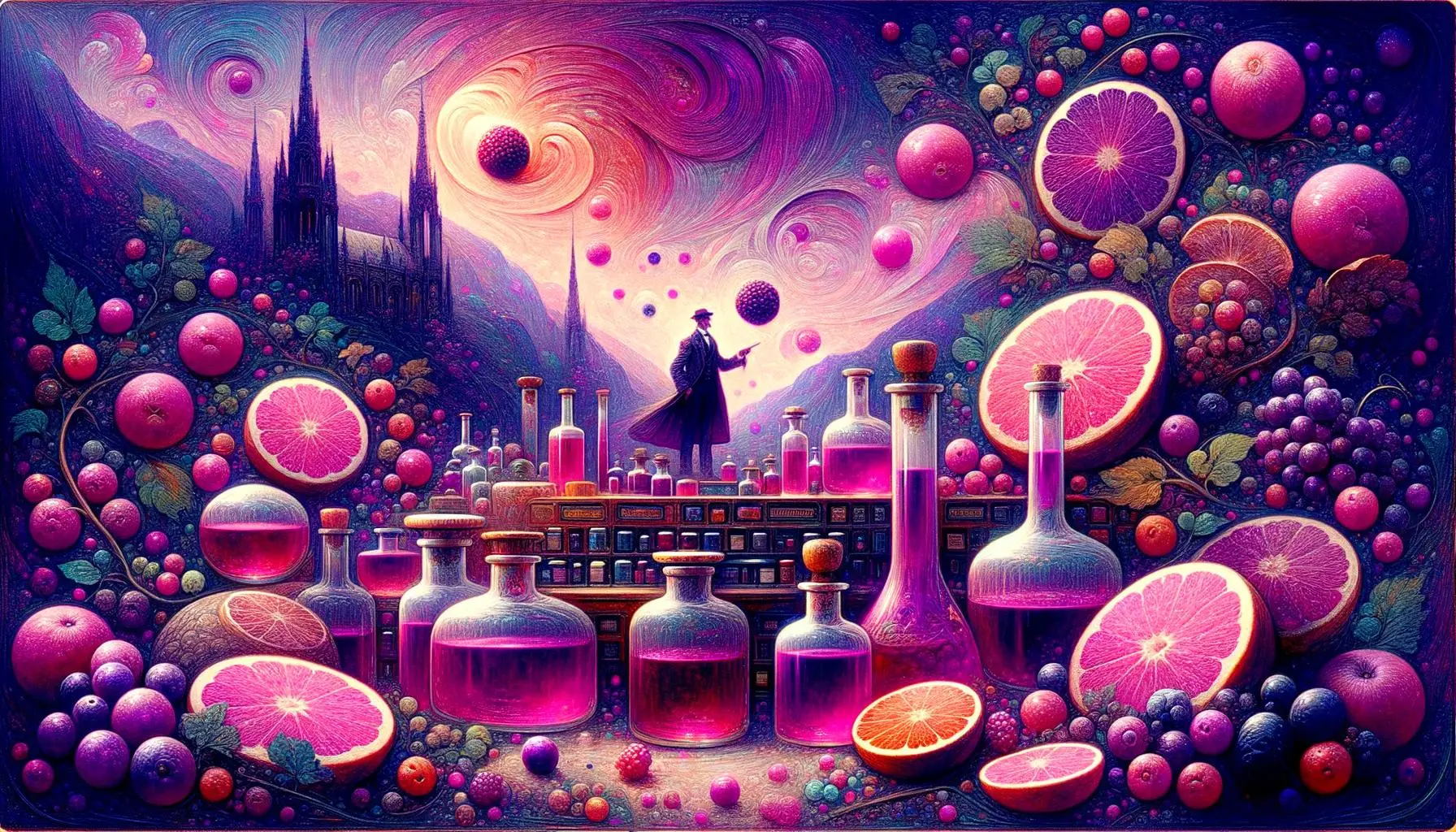
Maintaining an iron-rich diet while navigating the complex world of tannin-rich foods and beverages can be challenging. However, implementing specific dietary strategies can significantly enhance the absorption of iron. This is especially crucial for individuals who rely heavily on plant-based sources of iron, where tannins are more likely to impact the bioavailability of this essential nutrient. Here are practical ways to maximize iron absorption from your diet, even when consuming foods high in tannins.
Boosting Iron Absorption in the Presence of Tannins
If your diet includes a significant amount of tannin-rich foods like tea, coffee, and certain types of grains and legumes, understanding how to boost iron absorption can help mitigate the inhibitory effects of tannins. One of the most effective strategies is incorporating foods high in vitamin C into your meals. Vitamin C (ascorbic acid) is a powerful enhancer of iron absorption. It can convert iron into a form that is more readily absorbed by your body, counteracting the negative impact of tannins.
Key Strategies:
Combine Vitamin C with Meals: Including vitamin C-rich foods like oranges, kiwis, strawberries, bell peppers, and broccoli with your meals can significantly improve iron absorption. For example, squeezing lemon juice over a spinach salad not only adds flavor but also enhances the nutritional value of the meal.
Consider Iron Supplements: For individuals at risk of iron deficiency, considering iron supplementation, preferably under the guidance of a healthcare provider, can be a practical approach. Taking vitamin C supplements alongside iron can further enhance absorption.
Mind the Timing: Consuming tannin-rich beverages like tea and coffee between meals instead of with them can help reduce their impact on iron absorption. Aim to wait at least an hour after eating before enjoying these drinks.
Enhance with Cooking Methods: The method of food preparation can also influence iron absorption. Cooking with cast iron cookware, for instance, can increase the iron content of your food.
Diversify Iron Sources: Incorporating a diverse range of iron-rich foods into your diet can offset some of the absorption challenges posed by tannins. Focus on both heme iron (found in animal products) and non-heme iron (found in plant-based foods) sources.
Limit Inhibitors: Apart from tannins, other dietary components like calcium and phytates (found in whole grains and legumes) can also inhibit iron absorption. Being mindful of these and not consuming them with iron-rich meals can help.
To put these strategies into practice, here’s a simple checklist you can refer to when planning your meals:
- [ ] Include a vitamin C-rich food or beverage with every meal.
- [ ] Schedule tea, coffee, and other tannin-rich drinks between meals, not with them.
- [ ] Consider iron supplementation if at risk of deficiency, and pair with vitamin C.
- [ ] Utilize cooking methods that enhance iron absorption, such as using cast iron cookware.
- [ ] Include a variety of iron sources in your diet, both heme and non-heme.
- [ ] Be mindful of other absorption inhibitors like calcium and phytates during meal
planning.
By implementing these strategies, you can enjoy a diverse diet rich in tannins without significantly compromising your body’s ability to absorb iron. As always, discussing any significant dietary changes with a nutritionist or healthcare provider is advisable, especially for individuals with specific health concerns like iron deficiency anemia.
Incorporating Tannin-Rich Foods into a Balanced Diet

Identifying Tannin-Rich Foods and Beverages
Tannins are a unique group of astringent compounds that exist naturally in various foods and beverages. These compounds are particularly abundant in items such as tea, coffee, red wine, and certain fruits like grapes and persimmons. Nuts, especially walnuts and almonds, also contain a high level of these astringent compounds. Learning to identify which foods and drinks are rich in tannins is an essential step in managing your iron absorption effectively. Understanding this can help you make informed decisions about your diet, especially if you’re looking to optimize your dietary iron intake.
Timing Matters: When to Eat Tannin-Rich Foods
The timing of when you consume tannin-rich foods can significantly impact your body’s ability to absorb iron, especially non-heme iron found in plant sources. To minimize the inhibitory effects of tannins on iron absorption, consider consuming tannin-rich foods and beverages between meals. For instance, enjoying a cup of tea or coffee at least an hour before or after an iron-rich meal can help reduce their interaction, allowing your body to maximize iron absorption.
Combining Iron-Rich Foods with Vitamin C for Absorption
Consuming vitamin C alongside iron-rich foods is a beneficial strategy for enhancing iron absorption. Vitamin C, a potent antioxidant, transforms iron into a form that is more easily absorbed by the body. This is particularly helpful when consuming non-heme iron sources, such as leafy greens and legumes, that aren’t absorbed as efficiently as the heme iron found in animal products.
For optimizing iron absorption, consider incorporating the following combinations into your meals:
- Adding slices of strawberries, oranges, or bell peppers to a spinach salad
- Squeezing lemon juice over lentils or chickpeas
- Consuming vitamin C-rich fruit alongside fortified breakfast cereals
Practical Tips for Individuals with Iron Deficiency
For individuals dealing with iron deficiency, carefully planning your diet to include both iron-rich foods and elements that enhance iron absorption is crucial. Here’s a practical checklist to assist in dietary planning:
- [ ] Include a source of vitamin C with every meal, especially when consuming plant-based
iron sources.
- [ ] Limit the intake of tannin-rich foods and beverages around meal times to minimize their
impact on iron absorption.
- [ ] Focus on iron-rich foods such as leafy greens, legumes, and fortified cereals as part of
your daily diet.
- [ ] Consider iron supplementation under the guidance of a healthcare professional,
especially if dietary adjustments alone are insufficient.
- [ ] Regularly monitor your iron levels through blood tests to assess the effectiveness of
your dietary strategies.
By understanding the relationship between tannins and iron, and implementing these nutritional strategies, individuals can effectively manage their iron levels and work towards achieving optimal health through their diet.
FAQs on Tannins and Iron Absorption
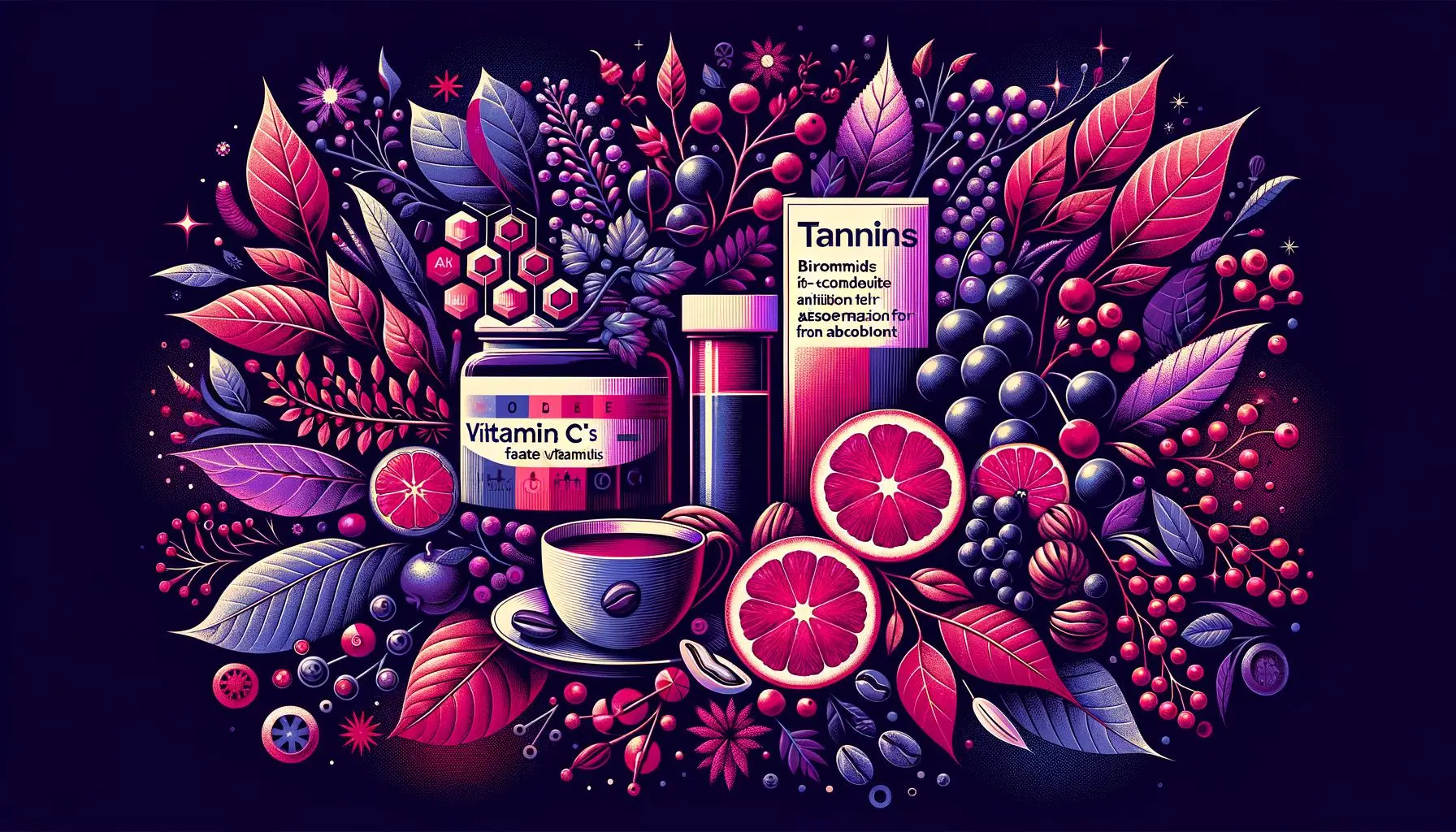
Can Drinking Coffee or Tea with Meals Significantly Decrease Iron Absorption?
When considering a diet rich in tannins and its impact on iron absorption, a frequent question arises regarding the consumption of coffee or tea alongside meals. Indeed, it’s well-documented that these tannin-rich beverages can inhibit the body’s ability to absorb iron, particularly the non-heme type found predominantly in plant-based iron sources. This effect is most pronounced when such beverages are consumed concurrently with iron-rich meals.
The key mechanism behind this is the binding of tannins to iron, rendering it unavailable for absorption in the digestive tract. This interaction primarily affects non-heme iron, which means that individuals relying heavily on plant-based sources of iron need to be particularly mindful of their consumption habits around meals.
The extent of the decrease in iron absorption can be significant, and it’s advised that those with iron deficiency or those at risk of it allow a window of time between consuming these beverages and iron-rich foods. A practical guideline is to wait at least 30 minutes to an hour after meals before indulging in your tea or coffee to minimize the impact on iron absorption.
What Are the Best Sources of Vitamin C to Enhance Iron Absorption?
Vitamin C, known for its potent antioxidant properties, also plays a crucial role in enhancing the absorption of dietary iron. This nutrient can counteract the inhibiting effects of substances like tannins, particularly on non-heme iron absorption. For those looking to optimize their iron intake, incorporating vitamin C-rich foods into every meal can make a significant difference.
Excellent sources of vitamin C include:
- Citrus fruits such as oranges, lemons, and grapefruits
- Strawberries, kiwi, and papaya
- Bell peppers and tomatoes
- Leafy greens like kale and spinach
- Cruciferous vegetables such as broccoli and Brussels sprouts
Incorporating these foods into iron-rich meals can enhance iron bioavailability, making them an essential component of nutritional strategies for individuals with dietary iron concerns.
Are Tannins Harmful to Individuals with Iron Deficiency Anemia?
Tannins, while known for their astringent compounds and antioxidant properties, have a dual nature when it comes to nutrition. For individuals with iron deficiency anemia, the consumption of tannin-rich foods and beverages could potentially exacerbate the condition due to their ability to inhibit iron absorption.
It’s essential for those with iron deficiency to understand the impact of tannins on their condition. However, this does not mean that all tannin-containing foods must be avoided. Instead, mindful consumption and strategic dietary planning can help mitigate the negative effects while still allowing individuals to enjoy the health benefits of foods with antioxidant properties.
A balanced approach involves:
- Timing the consumption of tannin-rich beverages to avoid immediate intake before or after iron-rich meals.
- Enhancing iron absorption through the concurrent intake of vitamin C-rich foods.
- Consulting healthcare providers for tailored advice on iron supplementation if necessary.
- [ ] Schedule tannin-rich beverages (tea, coffee) at least an hour after meals.
- [ ] Include a source of vitamin C with every meal to enhance iron absorption.
- [ ] Regularly monitor iron levels, especially for those with a history of iron deficiency.
- [ ] Seek professional advice regarding iron supplementation if dietary adjustments are not
sufficient.
In conclusion, while tannins can interfere with iron absorption, their impact can be managed with informed dietary choices. Through the strategic timing of consumption and the incorporation of vitamin C-rich foods, individuals can navigate a tannin-rich diet without compromising their iron status.
Conclusion - Navigating Through a Tannin-Rich Diet
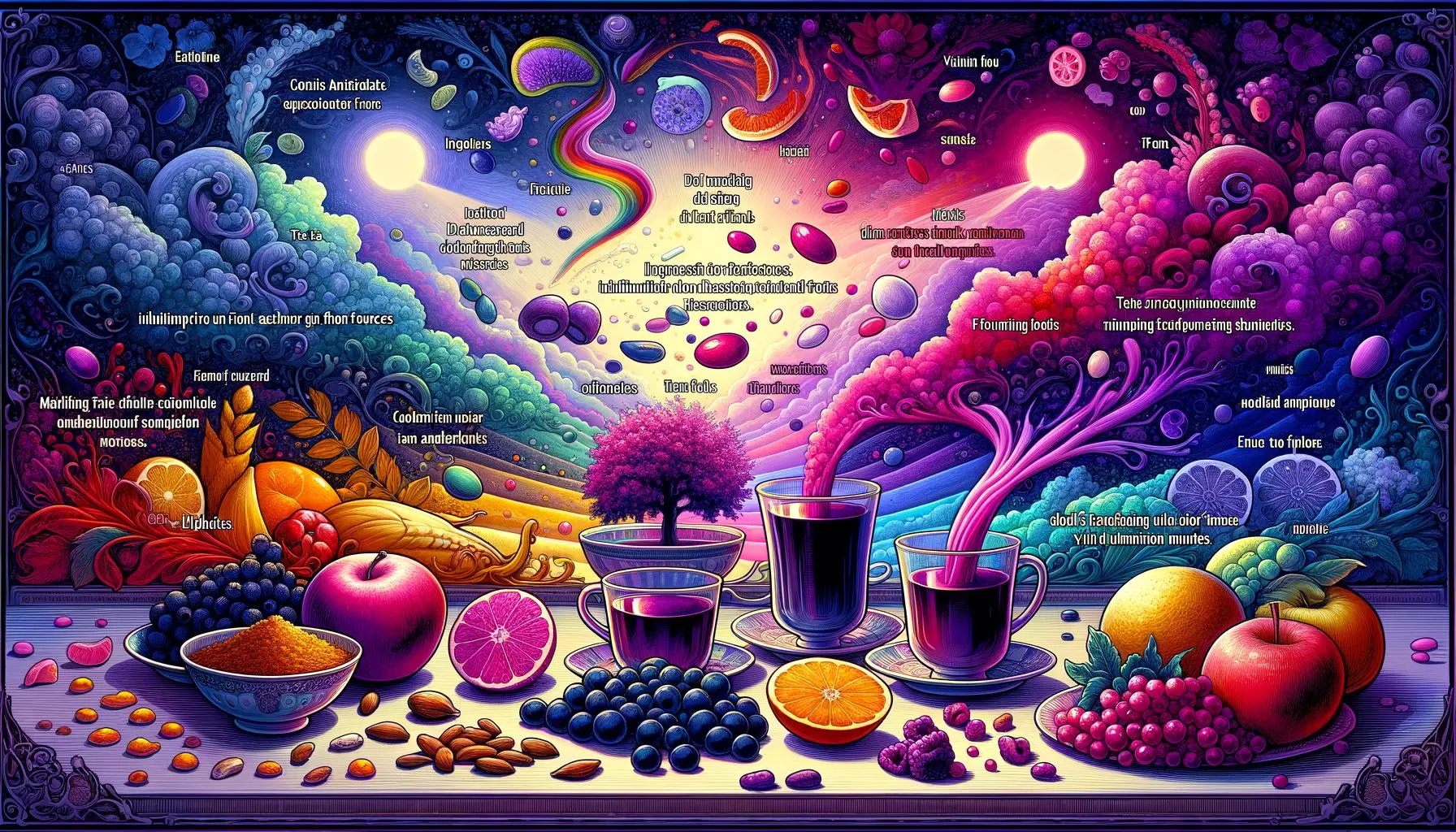
As we draw to a close on our journey through understanding how tannins interact with iron absorption and the various strategies one can implement to optimize dietary iron, it’s clear that the topic encompasses more than just eating the right foods. It involves a thoughtful approach to how we consume tannin-rich foods and beverages in relation to iron-rich meals. The goal is not to avoid tannins entirely, as they carry significant antioxidant properties, but to consume them in a way that supports, rather than inhibits, iron absorption—especially for those who struggle with iron deficiency or are seeking to maintain optimal health.
Synthesizing Dietary Strategies for Optimal Health
Through the article, we’ve explored how the interaction between tannins and iron, while complex, doesn’t amount to an insurmountable barrier. Instead, it presents an opportunity to refine our dietary habits for better nutrition. Here’s a concise checklist to guide you in optimizing iron absorption while enjoying a diet that includes tannin-rich foods and beverages:
- [ ] Pair iron-rich foods with vitamin C sources at meals to enhance absorption.
- [ ] Try to consume tannin-rich beverages, like tea and coffee, between meals instead of with
them.
- [ ] Incorporate a variety of iron sources in your diet, focusing on both plant-based and
animal-based iron.
- [ ] If you have a condition that impacts iron absorption or are at risk of iron deficiency,
consult with a healthcare provider about iron supplementation.
- [ ] Stay informed on the latest nutritional strategies and research to refine your dietary
choices continuously.
Navigating through a tannin-rich diet effectively means making informed choices that align with your body’s needs. By adopting a balanced approach to nutrition that accounts for the inhibitory effects of tannins on iron absorption while leveraging the benefits of other dietary components like vitamin C, you can foster better health and wellbeing.
Embrace the diversity of foods available, and remember, the joy of eating well is not just about nourishment but the pleasure and social connections food brings to our lives. Each meal is an opportunity to support your health, savor flavors, and share experiences with loved ones.
3 Relevant Links Optimizing Iron Absorption

In our journey through understanding and managing a tannin-rich diet for optimal iron absorption, we’ve covered everything from the basic science of how tannins and iron interact in our bodies to practical dietary strategies and tips. To further expand your knowledge and provide more resources to support your nutritional goals, here are three relevant links that delve deeper into the subjects of antioxidants, vitamin C’s role in iron absorption, and plant-based iron sources.
Benefits of Dietary Antioxidants This comprehensive guide introduces the health benefits of antioxidants, compounds which can combat oxidative stress. Tannins, known for their antioxidant properties, play a crucial role in this balance, making this resource particularly useful for those looking to understand the broader health implications of these astringent compounds.
Enhancing Iron Absorption with Vitamin C Since vitamin C can significantly boost iron absorption, especially non-heme iron from plant sources, this article provides invaluable insights into how you can efficiently incorporate vitamin C into your diet. From leafy greens to citrus fruits, discover the best sources of vitamin C to enhance iron bioavailability.
Iron Sources for Plant-Based Diets For vegetarians, vegans, and those focusing on plant-based iron sources, this resource is a goldmine of information. It outlines the top iron-rich foods suitable for a plant-based diet, offering alternatives and practical tips to ensure you’re meeting your dietary iron needs without compromising on nutritional value.
To make the most out of these resources, here’s a quick checklist to keep in mind as you navigate through optimizing iron absorption in your diet:
[ ] Integrate a variety of iron-rich foods into your meals daily.
[ ] Pair iron-rich foods with vitamin C sources to enhance absorption.
[ ] Limit intake of tannin-rich beverages around meal times.
[ ] Consider the timing and combination of foods to maximize nutrient absorption.
[ ] Monitor your iron levels and consult with a healthcare provider if you suspect an iron
deficiency.
By staying informed and mindful of how tannins, iron, and other dietary factors interact, you can effectively navigate a tannin-rich diet while maintaining optimal iron levels. Remember, the goal is to strike a balance that supports your body’s nutritional needs and overall health. These resources, alongside the strategies discussed throughout our series, should serve as a valuable guide in your journey toward optimal nutrition and well-being.


